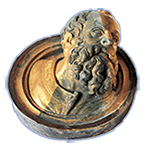Speaker
Description
A bronze horse harness recovered at roman colony “Bedaium” (50-200 AD, now “Seebruck am Chiemsee”) has been investigated by means of x-ray diffraction using a lab-based XRD instrument. The patina of such ancient bronzes impede access to the bulk material with standard Cu-XRD. Depending on it´s thickness, hard Mo radiation with higher penetration depth might enable a non-destructive analysis of the bulk material. In this study we show the potential but also the limitations of such lab XRD systems as a complementary method to neutron diffraction (ND).
The results show that hard x-rays can penetrate thin patina layers to get suitable signals from the bulk. From Rietveld refinement of Mo-XRD data a pure CuSn bronze with a Sn content of 4.3% without any additional alloying elements has been determined. The unit cell of the fcc CuSn solid solution α-phase is increased by 0.8% due to Sn admixture compare to pure Cu. Using Vegard´s law for random substitutional solid solutions, a Sn content of 4.5% has been calculated which is in good agreement with Rietveld results.
Depending on burial conditions and alloy composition, the corrosion products of ancient bronzes also yield information about the composition of the bronze itself. XRD examinations of patina revealed corrosion products mainly of cuprite and malachite which affirm the absence of Pb, Fe and Zn in the alloy.
The results have been verified by ND measurements which allows to investigate mainly the whole bulk material.

